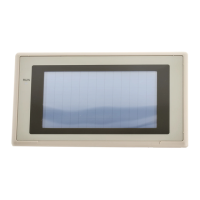2-5SectionImage and Library Data
109
Relationship with Other Elements
• Difference between image data and library data
Image data can take any form for it is composed of dots, but library data can
only be created by assembling fixed display text and graphics.
Since only drawing information for characters and graphics is registered for
library data, library data takes up less memory area than image data, which
requires all the dots to be displayed on the screen to be registered as data.
Another difference is that flash and inverse display are not possible for
image data, but library data can be displayed in these modes in accordance
with the display attributes of the registered elements. The timing of the flash-
ing is the same for all elements.
• It is possible to specify different image/library data for the graphic displayed
when a lamp (image/library lamp) is ON and OFF (page 112).
• It is possible to specify different image/library data for each message displayed
for the alarm list/alarm history function (page 182).
• Image data elements overlap with other fixed display elements in accordance
with the order in which they were registered. However, the way in which they
overlap can be changed with the Support Tool.
2-5-2 Library Data Display
Library data are combinations of multiple fixed display text and graphic elements
registered as single elements. Library data can be registered in any required
size.
Library data are created with the library editor of the Support Tool, independently
of screens, and as many as required can be displayed at any position on any
screen.
Registering frequently used and complex images as library data allows them to
be displayed easily whenever required.
There are two ways to display library data. Library data can be displayed by di-
rectly specifying the code number (fixed code) or indirectly specifying the code
number through a numeral memory table entry (indirect specification).
When the code is specified indirectly, the displayed library can be changed just
by overwriting the code number in the numeral table entry, in the same way that
indirectly specified numeral/character string displays can be changed. If indirect
specification is used, displayed libraries can be changed with a simple program
that just changes the contents of a numeral memory table entry and a series of
libraries can be displayed to generate a dynamic screen.
Since the individual elements within a library data are displayed in the order they
were created with the Support Tool (graphics created early are overlaid by those
created later), the order must be considered when creating them.
Complex data can
be displayed as
many times as
required.
Library data
Reference: When the PT is in NT20S or NT30/620 compatible mode, the library codes and
maximum number of libraries are the same as the NT30C, NT620S, NT620C,
and NT625 PTs. Refer to Appendix C for details on the NT20S and NT30/620
compatible modes (page 451).
Function Outline

